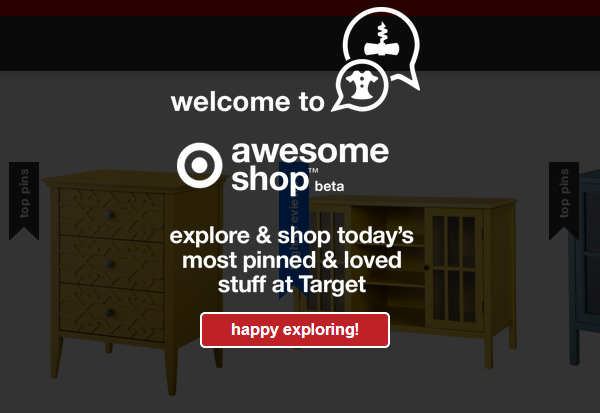 Target’s new Awesome Shop is an experiment that hopes to build hype for particular projects through two separate methods. The first is Pinterest, making use of ecommerce’s darling social media platform. The second, offering even more social proof than even Pinterest can provide, is through organized customer reviews. So, how does the site work, and what benefits could it provide for Target outside of product hype?
Target’s new Awesome Shop is an experiment that hopes to build hype for particular projects through two separate methods. The first is Pinterest, making use of ecommerce’s darling social media platform. The second, offering even more social proof than even Pinterest can provide, is through organized customer reviews. So, how does the site work, and what benefits could it provide for Target outside of product hype?
How to Find It
The site is attached to the Target.com site, which makes location easy. By typing in AwesomeShop.Target.com (which itself is a good idea, since it condenses the SEO authority), consumers will be presented with a curated list of products that meet two separate requirements. The first is most-pinned, and the second is highest-reviewed. Because consumer opinion changes on a daily basis, the list will, too. Most days feature more than one thousand products at a time on scroll page that doesn’t end until the product list does. No need to click to new pages for further product suggestions, which means buyers can easily locate the products that interested them after perusing all that are offered.
What Buyers See
If consumers like a product, they can click for more information. A pop-up appears with the number of reviews and pins recently added, as well as a price range for the product.

By clicking “view details,” buyers can move straight to the Target website, where purchase of the product can be completed.
Social Validation
The real benefit to the retailer and buyers alike is social proof. Pinterest has made building hype for products sold online a reality, and Target has taken full advantage of the phenomenon. Items that may have once escaped notice can cause quite a stir from just one pin. As more Pinterest users discover that product and re-pin to their own boards, the product gains in popularity, which results in a higher demand.
How to Adopt Similar Strategies
Target has its own Rapid Accelerated Development group, which put together the Awesome Shop in a matter of weeks. Your ecommerce company may not have such resources at the ready, but you can still introduce variants of this model for your site with some time and effort.
The first step is to create your own page of most-pinned items. Your business account on Pinterest will allow you to keep track of the products people love to see. Simply use that information on your own site instead of leaving the two entities separate. You can also create a favorites page that allows you to share the items on your site that receive the highest reviews. Make sure each product you feature on these sites links directly back to the landing page for the product in question so buyers have a direct link for purchasing.
Share your hyped items on other forms of social media so you’re not relying only on Pinterest to bring you traffic. As more consumers see your products grow in popularity, they’ll want to know what all the fuss is about. You’ll then perpetuate the cycle as those products are pinned again and again.
Other Benefits Your Site Receives
By creating a new page for these items, you also benefit from a boost in SEO. Target, because the new Awesome Shop is a part of the parent site, experiences excellent SEO benefits each time one of the products is searched and located on the Awesome Shop site (as opposed to them launching TargetAwesomeShop.com). The same could apply to your site. When someone searches for reviews on your products, they’ll land directly on your site instead of a third-party review site.
You may not reach Number 18 on the Internet Retailer Top 500 Guide as Target has, but you can get some "awesome" revenue results.


